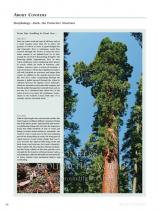 Sequoiadendron giganteum - GIANT SEQUOIA
Sequoiadendron giganteum - GIANT SEQUOIA
SEQUOIADENDRON GIGANTEUM
GIANT SEQUOIA
Sequoiadendron giganteum (Lindl.) J. Buchholz
Featuring "charismatic" species, like Giant Sequoia, in Conifers Around the World has been somewhat different than in most cases. The largest and smallest conifers are equally treated in the book with species descriptions about 1800 characters long. We only made additional discussions when unique features, natural history phenomena or taxonomical issues required more details. In the case of this monotypic species, the genus description (Vol. 1, page 121) provides the basic morphological details, which allowed (as in other cases) the species description, page 647, to focus more on the natural history. In the introductory part, page 38 briefly refers to the interesting question of "how can water reach the tops of tall trees such as a Giant Sequoia more than 80 m above the ground, …" and "how the water evaporating through the stomata is pulled upward through the xylem by cohesion between the bipolar water molecules". In the Western North America chapter, Vol. 2, we were permitted to use a photo of the General Sherman tree that appeared in National Geographic Magazine (1957; the tree has lost a major branch in 2006 so a recent photo would look somewhat different). The range of the species is given on page 566 alongside a photograph by Jeff Bisbee (Nevada) of a group of trees in Mariposa Grove. Since 1853, Giant Sequoia is widely planted as a landscape tree in the temperate zones; one example of an arboretum view is shown here from Wakehurst Place.























Recent comments
8 weeks 4 days ago